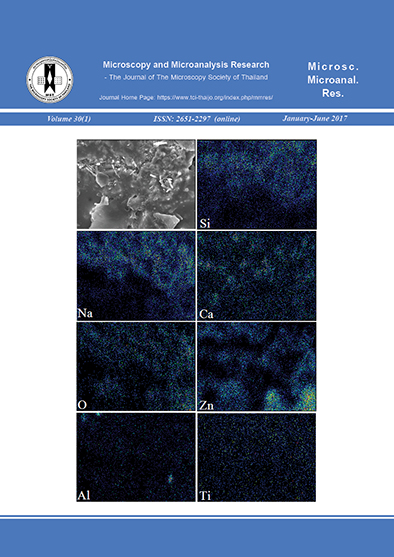Freeze Drying versus Chemical Fixation Technique for Scanning Electron Microscope of Succulent and Aquatic Plant Leaves
Main Article Content
Abstract
The maintenance of perfect leaf surface structure is important for morphological study by scanning electron microscope (SEM). Researchers normally use a chemical fixation technique to prepare the leaf samples because it obtains a good result to preserve leaf surface structures. Although chemical fixation is a popular technique, it is harmful to users and environment. Freeze drying is another good technique to prepare the samples for observation by SEM because it is safer than chemical use. The aim of this study is to investigate the optimum time duration of freeze drying for leaf samples of a succulent (Pepperomia pellucida (L.) Korth) and an aquatic (Limnophila heterophylla (Roxb) Benth) plant. When samples of P. pellucida and L. heterophylla were subjected to both techniques, the complete structure of the leaf surface was preserved. The leaves of both species took different periods of time to dry. P. pellucida took 36 hrs while L. heterophylla needed only 24 hrs. However, the compounds used in the chemical fixation are harmful and may contaminate the environment. Therefore, the freeze drying technique is a good way to prepare leaf samples for SEM analysis.
Article Details
References
2. A.K. Pathan, J. Bond and R.E. Gaskin, Sample preparation for SEM of plant surfaces, Materialstoday.,12, Electron Microscopy special Issue, 2009,32-43.
3. M.A. Hayat, Principles and Techniques of Electron Microscopy Biological Applications, fourth ed., Cambridge University Press, Cambridge, 2000.
4. D.G. Robinson, U. Ehlers, R. Herken, B. Herrmann, F. Mayer and F.W. Schurmann, Methods of Preparation for Electron Microscopy, Springer-Verlag, New York, 1987.
5. S.L. Flegler, J.W. Heckman and K.L. Klomparens, Scanning and Transmission Electron Microscopy An Introduction, Oxford University Press, New York, 1993.
6. A. von Humboldt, A.J.A. Bonpland and C.S. Kunth, Flora of North America, 1816.
7. C.D.K. Cook, Aquatic Plant Book, SPB Academic Publishing, Amsterdam, 1996.
8. Y. Paisooksantivatana and K. Nakahara, Local Vegetables of Thailand: Color illustrated, Japan International Research Center for Agricultural Sciences (JIRCAS) and Kasetsart University, 2009.
9. D. Gorai, S.K. Jash and R.K. Singh, Chemical and phamacological aspects of Limnophila heterophylla (Scrophulariaceae): An Overview, Int, J. Pharm. Sci. Rev. Res., 2014, 25(2), 100-120.


